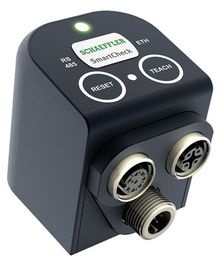Supported device types and versions
Configuration of communication
Literature
Document revisions
The SmartCheck from Schaeffler is a compact, innovative, modular online measuring system for continuous monitoring of machinery and process parameters on a decentralized basis. It can be used on assemblies where such monitoring was previously too costly.
The SmartCheck is suitable for early detection of rolling bearing damage, imbalances, and misalignments on:
- Electric and geared motors
- Vacuum and fluid pumps
- Ventilators and fans
- Gearboxes and compressors
- Spindles and machine tools
Supported device types and versions
The communication with the FAG SmartCheck device has been tested on several devices with the following parameters:
- Build date: 20170502_164020 / 20171207_094937
- Build number: 395886 / 395947
- Firmware: 1.12.2 / 1.12.30
The protocol for communication with the FAG SmartCheck vibrometer is implemented as a Java server event in D2000.
If the FAG SmartCheck is connected to the local network, it is possible to connect to it using its IP address. Java event communicates with the device by using XML Soap (Simple Object Access Protocol) via HTTP requests. Several types of requests can be sent to the device, D2000 implementation of FAG SmartCheck protocol uses three types of requests:
- Load device configuration, where configuration contains basic information about sensors measuring values.
- Based on the configuration of the device, the querying of "live" data from the device follows. These data are collected by device in real-time, such as vibration, temperature, voltage, load, and the rotational speed of the device (rotational speed requires connecting external sensor).
- The last type of request is to query alarm data from the device. This data is the result of individual signals within "jobs" triggered periodically (e.g. once per minute).
Communication with the FAG SmartCheck is established using the IP address of the device, by the following procedure:
Based on the username and password to access the device, the above-mentioned requests are continuously generated as needed and sent to the device.- The device sends responses to the requests with different information depending on the request.
The device sends responses related to values - vibration, temperature, voltage, load and speed, as well as responses related to alarms for individual signals within "jobs" - AlarmType, PreAlarmLevel, MainAlarmLevel, PreAlarmCount (number of pre-alarms), MainAlarmCount (number of high alarms).
Configuration of communication
The SV.FAG.SmartCheck.Parameters structured variable is used to configure communication. This structure has to be resized to as many rows as there are devices. The meaning of each column is as follows:
- DeviceName - Device name defined by the user (not used in the communication).
- IP - IP address of the device. Example: 172.16.1.128
- User - Username to log in to the device.
- Password - Password to login to the device.
- PeriodValues - The period (in seconds) at which measured values are read from the device.
- Active - Determines whether the communication is active or not.
- True - The communication is active.
- False - The communication is disabled (e.g. if it is necessary to access the device's web interface for configuration).
The output from the communication is written to the structured variable SV.FAG.SmartCheck.Values, which has as many rows, as there are devices (if needed, it is automatically resized). The meaning of each column is as follows:
- Vibration - Device vibrations (g)
- Temperature - Device temperature (°C or °F depending on the configuration of the device)
- Voltage - Device voltage (V)
- Load - Device load (%)
- DigitalInput - Device rotational speed (rpm)
- Status - State of communication. It can take on the following values:
- 0 - Connected - Connected to the device.
- 1 - Disconnected - Disconnected from the device.
- 2 - Connection error - Could not connect to the device (e.g. the device is not connected to the network, or the machine's IP address is invalid)
- 3- Login error - Username or password is incorrect
Using D2000, it is possible to watch alarm data of jobs with several signals configured via the web interface. For this purpose, the SV.FAG.SmartCheck.Alarms structure variable is intended. The meaning of each column is as follows:
- FAG_ID - ID of FAG device, which corresponds with the row index of the device in SV.FAG.SmartCheck.Parameters structure.
- JobName - Name of the job according to the configuration in the web interface.
- Signal - Name of the signal within the job according to the configuration in the web interface.
- CurrentValue - Measured signal value at the last measurement.
- AlarmType - Alarm type for the signal.
- No-Alarm - No alarm.
- Pre-Alarm - Pre-Alarm.
- Main-Alarm - High Alarm.
- PreAlarmLevel - The value at which the Pre-Alarm is triggered. This value can be configured using the web interface.
- MainAlarmLevel - The value at which the Main-Alarm is triggered. This value can be configured using the web interface.
- PreAlarmCount - Number of Pre-Alarms for the signal.
- MainAlarmCount - Number of Main-Alarms for the signal.
Web interface - Job configuration:
SV.FAG.SmartCheck.Alarms structure:
If interested in this protocol, please contact the D2000 development department.
Literature
Blog
You can read a blog about FAG SmartCheck protocol:
Document revisions
- Ver. 1.0 - August 6th, 2019 - Document creation.
- Ver. 1.1 - August 28th, 2019 - Extension of functionality by obtaining alarm values for signals within jobs.
Related pages:





0 komentárov